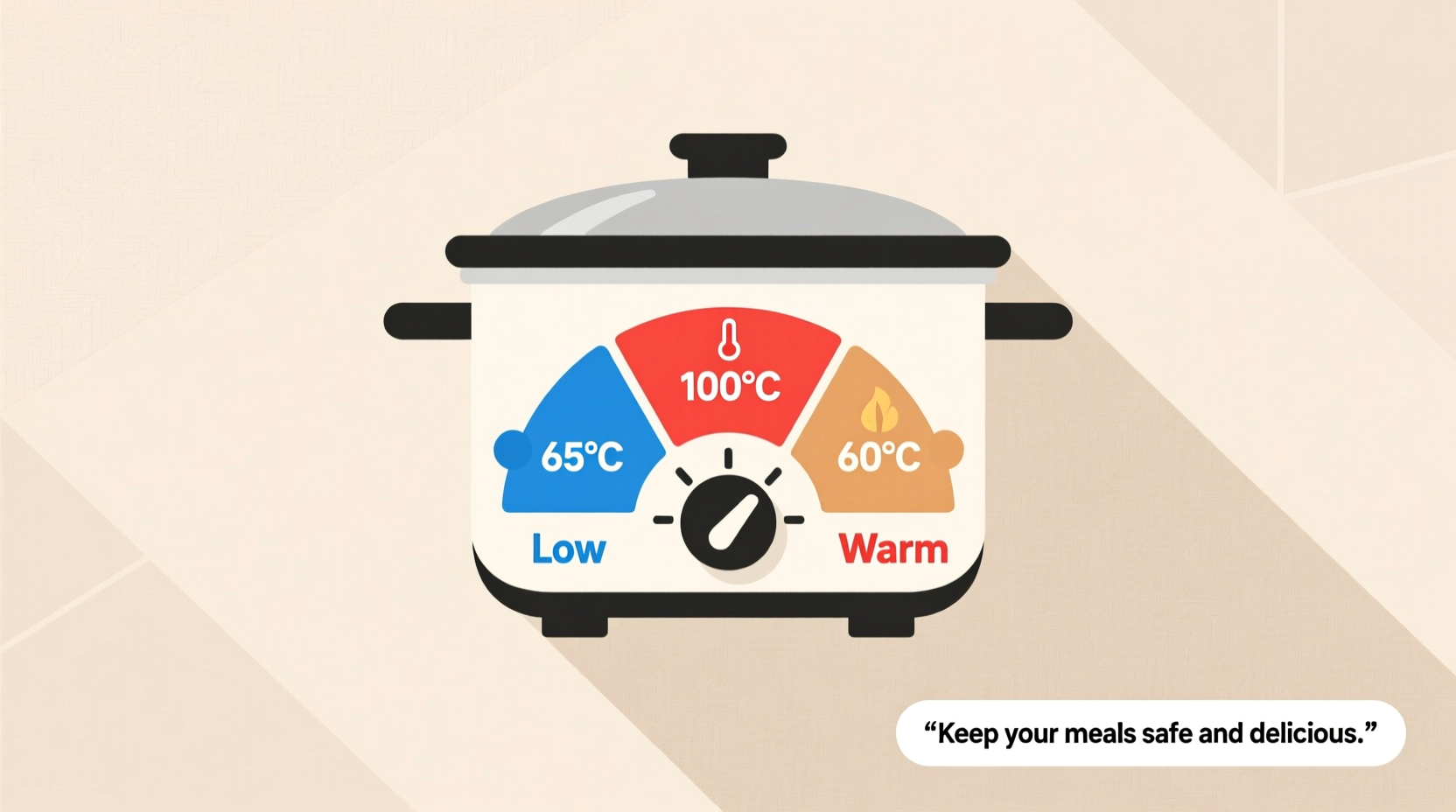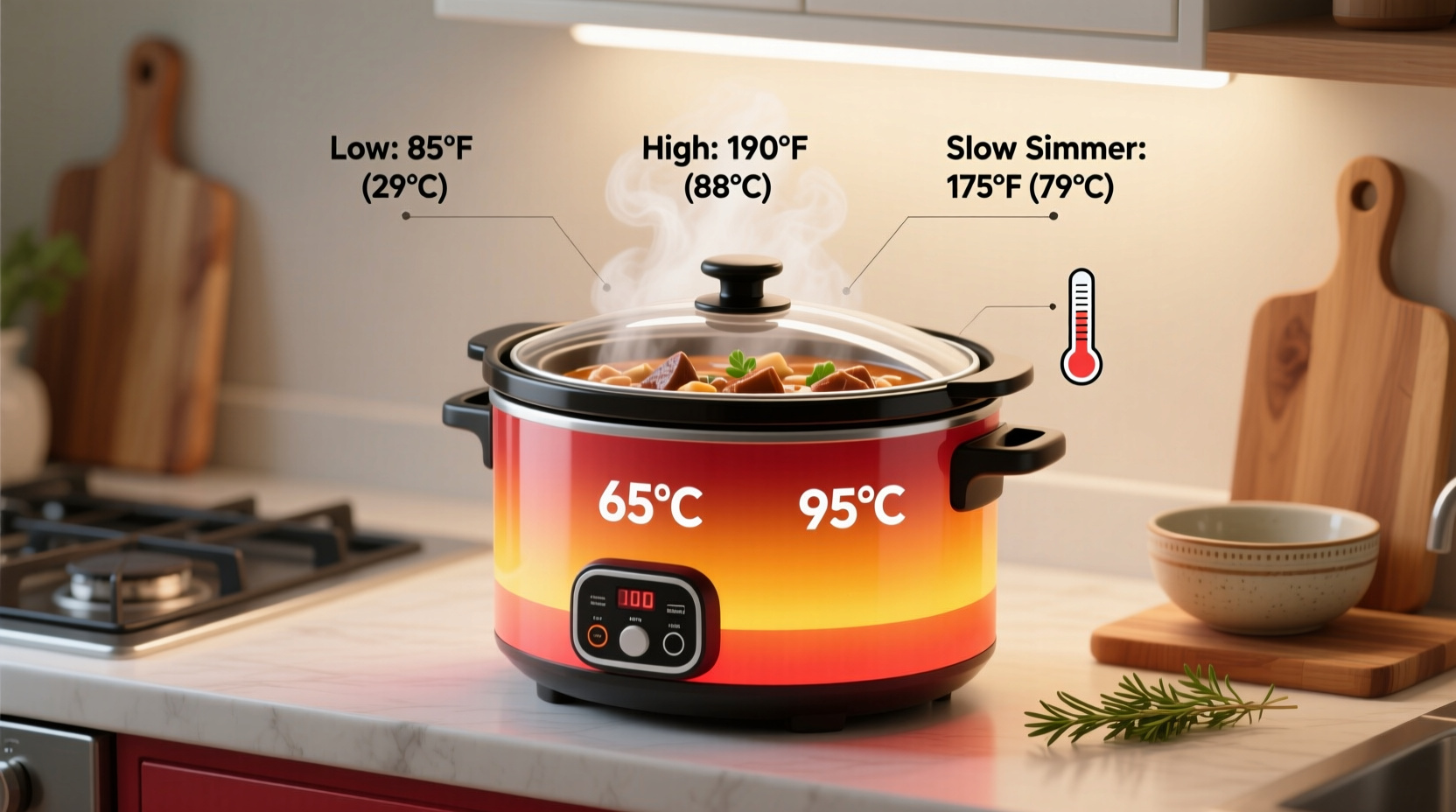Understanding slow cooker temperatures is essential for both food safety and culinary success. Contrary to what the name suggests, slow cookers don't actually cook at low temperatures—they maintain a consistent heat that safely brings food through the danger zone (40°F-140°F) within two hours, then continues cooking at optimal temperatures for tender, flavorful results.
How Slow Cookers Maintain Safe Cooking Temperatures
Slow cookers work by surrounding your ingredients with consistent, moist heat that gradually breaks down connective tissues in meats while preserving moisture. Unlike conventional ovens that rely on dry heat, the sealed environment of a slow cooker creates steam that circulates within the pot, maintaining precise temperatures throughout the cooking process.
The U.S. Department of Agriculture's Food Safety and Inspection Service confirms that slow cookers reach temperatures high enough to destroy harmful bacteria when used according to manufacturer instructions. Their research shows that properly functioning slow cookers maintain temperatures well above the 140°F minimum required for safe food preparation.
Slow Cooker Temperature Settings Explained
Understanding the difference between your slow cooker's settings helps you choose the right cooking method for each recipe. Here's what happens at each setting:
| Setting | Temperature Range | Time to Reach Simmer | Best For |
|---|---|---|---|
| Low | 190-200°F (88-93°C) | 7-8 hours | Tougher cuts of meat, bone broth, recipes requiring 8+ hours |
| High | 280-300°F (138-149°C) | 3-4 hours | Lean meats, vegetables, recipes needing 4-6 hours |
| Warm | 165°F (74°C) | N/A | Holding finished dishes before serving |
Food Safety Considerations for Slow Cooking
While slow cookers are generally safe when used properly, certain conditions can prevent them from reaching safe temperatures. The National Center for Home Food Preservation notes that filling your slow cooker beyond two-thirds capacity can significantly increase the time it takes to reach safe temperatures, potentially allowing bacteria to multiply.
Additional factors that affect temperature performance include:
- Starting with frozen ingredients (adds 1-2 hours to heating time)
- Older models with worn heating elements
- Frequent lid lifting (each opening drops temperature by 10-15°F)
- Altitude (higher elevations require longer cooking times)

Practical Temperature Tips for Perfect Slow Cooking
For consistently delicious results, follow these temperature-tested techniques:
Pre-Heat for Faster Cooking
Browning meats and sautéing vegetables before adding them to your slow cooker not only develops flavor but also raises the starting temperature of your ingredients, helping the cooker reach safe temperatures more quickly. This simple step reduces the time food spends in the danger zone by up to 50%.
Use the Right Amount of Liquid
Unlike stovetop cooking, slow cookers require less liquid because evaporation is minimal. As a general rule, reduce liquid by 25% compared to conventional recipes. Too much liquid can lower the cooking temperature and result in watery dishes.
Check Internal Temperatures
For complete food safety assurance, use a digital thermometer to verify that meats have reached proper internal temperatures:
- Poultry: 165°F (74°C)
- Beef, pork, veal, lamb roasts: 145°F (63°C) with 3-minute rest
- Ground meats: 160°F (71°C)
When Slow Cookers Might Not Reach Proper Temperatures
While modern slow cookers are designed to maintain safe temperatures, certain situations require extra attention:
Older models manufactured before 2010 may have less precise temperature control. If you're using a vintage slow cooker, consider testing its actual temperature by filling it with water, setting it to low, and checking the temperature after 8 hours with a reliable thermometer.
The FDA Food Code specifies that potentially hazardous foods must be held above 135°F (57°C) to prevent bacterial growth. According to their guidelines, slow cookers should maintain temperatures well above this threshold during the cooking process, but the warm setting may only keep food at the minimum safe holding temperature.
Temperature Troubleshooting Guide
If your slow cooker isn't performing as expected, these temperature-related issues might be the cause:
- Food not reaching safe temperatures: Test with a thermometer; replace if consistently below 185°F on low setting after 8 hours
- Uneven cooking: Stir ingredients halfway through cooking time to redistribute heat
- Excessive liquid: Reduce liquid by 25% or prop lid slightly ajar during last hour of cooking
- Burning on bottom: Ensure at least 1¼ cups liquid in cooker and avoid overfilling
Advanced Temperature Techniques for Culinary Excellence
Professional chefs use specific temperature strategies to maximize flavor development in slow cooking:
For optimal collagen breakdown in tough cuts of meat, maintain temperatures between 160-180°F for extended periods. This "low and slow" approach transforms connective tissue into gelatin without overcooking muscle fibers. The sweet spot for beef chuck or pork shoulder is maintaining 195°F for 8-10 hours—hot enough to break down collagen but cool enough to prevent the meat from becoming dry.
Understanding these precise temperature dynamics helps explain why some slow cooker recipes succeed while others disappoint. The difference between fork-tender brisket and stringy, dry meat often comes down to maintaining that critical 190-205°F temperature range throughout the cooking process.
Can slow cookers reach boiling temperature?
Most slow cookers don't reach a full rolling boil (212°F/100°C) on low setting, typically maintaining 190-200°F. On high setting, they may briefly reach 212°F but won't sustain a vigorous boil like a stovetop. The cooking environment creates a gentle simmer that's ideal for tenderizing tough cuts without drying out ingredients.
How do I know if my slow cooker is reaching safe temperatures?
Test your slow cooker by filling it two-thirds full with water, setting it to low, and letting it run for 8 hours. Insert a reliable food thermometer without opening the lid frequently. Properly functioning slow cookers should register between 185-200°F on low setting. If below 185°F, consider replacing your unit for food safety reasons.
Why does my slow cooker recipe sometimes come out dry?
Dry results typically occur when cooking temperatures are too high for too long. Lean cuts like chicken breast can become dry if cooked beyond 165°F internal temperature. For moist results, use the low setting for tougher cuts (8+ hours) and high setting for leaner meats (4-6 hours), always checking internal temperature with a thermometer to avoid overcooking.
Do I need to adjust slow cooker temperatures for high altitudes?
Yes, at elevations above 3,000 feet, you should increase cooking time by 15-25% because water boils at lower temperatures. The USDA recommends adding approximately 5% more cooking time for every 1,000 feet above sea level. Avoid increasing the temperature setting, as this can lead to uneven cooking and potential burning on the bottom.
Can I use a slow cooker to keep food warm for serving?
Yes, the warm setting typically maintains food at about 165°F, which is above the minimum safe temperature of 140°F. However, food should not remain on warm for more than 2-4 hours. The FDA Food Code specifies that potentially hazardous foods should not be held in the temperature danger zone (40°F-140°F) for more than 2 hours, so use the warm setting only for short-term holding before serving.











 浙公网安备
33010002000092号
浙公网安备
33010002000092号 浙B2-20120091-4
浙B2-20120091-4